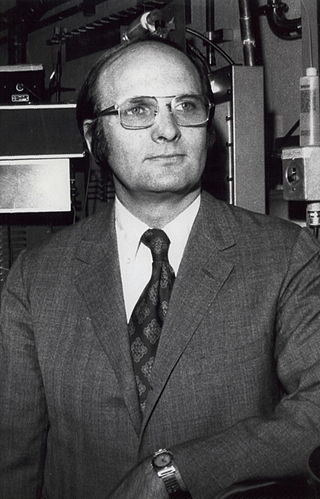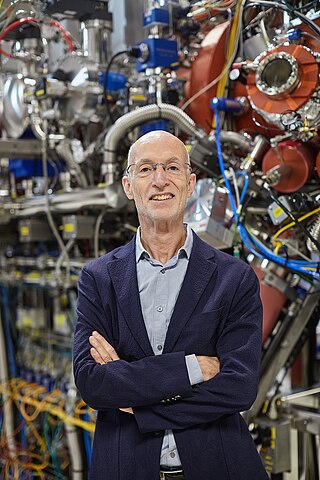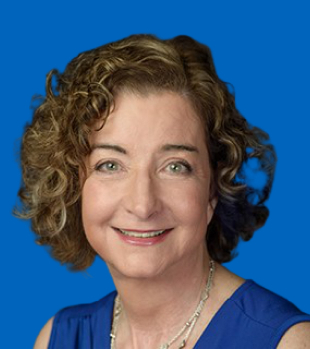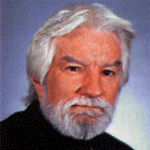
John Robert Schrieffer was an American physicist who, with John Bardeen and Leon Cooper, was a recipient of the 1972 Nobel Prize in Physics for developing the BCS theory, the first successful quantum theory of superconductivity.

A superconducting magnet is an electromagnet made from coils of superconducting wire. They must be cooled to cryogenic temperatures during operation. In its superconducting state the wire has no electrical resistance and therefore can conduct much larger electric currents than ordinary wire, creating intense magnetic fields. Superconducting magnets can produce stronger magnetic fields than all but the strongest non-superconducting electromagnets, and large superconducting magnets can be cheaper to operate because no energy is dissipated as heat in the windings. They are used in MRI instruments in hospitals, and in scientific equipment such as NMR spectrometers, mass spectrometers, fusion reactors and particle accelerators. They are also used for levitation, guidance and propulsion in a magnetic levitation (maglev) railway system being constructed in Japan.

Paul Ching Wu Chu is a Chinese-American physicist specializing in superconductivity, magnetism, and dielectrics. He is a professor of physics and T.L.L. Temple Chair of Science in the Physics Department at the University of Houston College of Natural Sciences and Mathematics. He was the president of the Hong Kong University of Science and Technology from 2001 to 2009. In 1987, he was one of the first scientists to demonstrate high-temperature superconductivity.

The National High Magnetic Field Laboratory (MagLab) is a facility at Florida State University, the University of Florida, and Los Alamos National Laboratory in New Mexico, that performs magnetic field research in physics, biology, bioengineering, chemistry, geochemistry, biochemistry. It is the only such facility in the US, and is among twelve high magnetic facilities worldwide. The lab is supported by the National Science Foundation and the state of Florida, and works in collaboration with private industry.

Stuart Stephen Papworth Parkin is an experimental physicist, director at the Max Planck Institute of Microstructure Physics in Halle and an Alexander von Humboldt Professor at the Institute of Physics of the Martin-Luther-University Halle-Wittenberg.
Innovation Park is the location of the National High Magnetic Field Laboratory, the Applied Superconductivity Center, Danfoss Turbocor and related advanced research facilities. The Leon County Research and Development Authority's Innovation Park is located near the campuses of Florida State University, Florida A&M University and Tallahassee Community College in Tallahassee, Florida.
Gregory Scott Boebinger was the director of the National High Magnetic Field Laboratory in Tallahassee, Florida, and is currently a professor of physics at Florida State University.
Naresh Dalal is a physical chemist who specializes in materials science. He is the Dirac Professor of Chemistry and Biochemistry at Florida State University, where he is affiliated with the National High Magnetic Field Laboratory.
The FAMU-FSU College of Engineering is the joint college of engineering of Florida A&M University and Florida State University. The College of Engineering was established as a joint program serving two universities in Tallahassee, Florida: The Florida Agricultural and Mechanical University, which received recognition from the National Academy of Sciences and the National Academy of Engineering in 2010 for ranking number one as the institution of origin for African Americans earning Doctorates in Natural Science and Engineering; and, Florida State University which has gained worldwide recognition for its extensive graduate and research programs. The college is located less than three miles from either university.
Juan Carlos Campuzano is a Paraguayan American physicist. He is a Distinguished Professor of Physics at the University of Illinois at Chicago. He was a Distinguished Fellow at Argonne National Laboratory, and a he is also a 2001 American Physical Society Fellow and a recipient of the 2011 Oliver Buckley Prize in Condensed Matter Physics. He is an expert in high-temperature superconductivity.

Amit Goyal is a SUNY Distinguished Professor and a SUNY Empire Innovation Professor at SUNY-Buffalo. He leads the Laboratory for Heteroepitaxial Growth of Functional Materials & Devices. He is also Director of the New York State Center of Excellence in Plastics Recycling Research & Innovation, an externally funded center with initial funding of $4.5M for three years at SUNY-Buffalo. He is the founding director of the multidisciplinary and transdisciplinary RENEW Institute at SUNY-Buffalo in Buffalo, New York and served as director from 2015-2021. RENEW is an internally funded research institute at SUNY-Buffalo. For his contributions to UB, in 2019, he was awarded the University at Buffalo or SUNY-Buffalo President's Medal, which recognizes “outstanding scholarly or artistic achievements, humanitarian acts, contributions of time or treasure, exemplary leadership or any other major contribution to the development of the University at Buffalo and the quality of life in the UB community.” This is one of the highest recognitions given at the university.
Merrill Brian Maple is an American physicist. He is a distinguished professor of physics and holds the Bernd T. Matthias Chair in the physics department at the University of California, San Diego, and conducts research at the university's Center for Advanced Nanoscience. He has also served as the director of UCSD's Institute for Pure and Applied Physical Sciences (1995-2009) and its Center for Interface and Materials Science (1990-2010). His primary research interest is condensed matter physics, involving phenomena like magnetism and superconductivity. He has authored or co-authored more than 900 scientific publications and five patents in correlated electron physics, high pressure physics, nano physics, and surface science.
George Ogurek Zimmerman, was a Polish-born American scientist, researcher, inventor, professor of physics and physics department chair at Boston University. Zimmerman achieved his PhD in solid state physics in 1963 at Yale University and came to Boston University in the fall of 1963.

Laura H. Greene is the Marie Krafft Professor of Physics at Florida State University and chief scientist at the National High Magnetic Field Laboratory. She was previously a professor of physics at the University of Illinois at Urbana-Champaign. In September 2021, she was appointed to the President's Council of Advisors on Science and Technology (PCAST).
Krityunjai Prasad Sinha was an Indian theoretical physicist and an emeritus professor at the Indian Institute of Science. Known for his research in solid-state physics and cosmology, Sinha was elected a fellow of all the three major Indian science academies – the Indian National Science Academy, the Indian Academy of Sciences, and the National Academy of Sciences, India. In 1974, the Council of Scientific and Industrial Research, the apex agency of the Government of India for scientific research, awarded him the Shanti Swarup Bhatnagar Prize for Science and Technology, one of the highest honors in Indian science, in recognition of his contributions to the field of physical sciences.

Judith Louise MacManus-Driscoll is a Professor of Materials Science at the University of Cambridge. Driscoll is known for her interdisciplinary work on thin film engineering. She has a particular focus on functional oxide systems, demonstrating new ways to engineer thin films to meet the required applications performance. She has worked extensively in the fields of high temperature superconductors, ferroics and multiferroics, ionics, and semiconductors. She holds several licensed patents.

Paul Michael Grant was an American/Irish physicist and science writer who was involved in discovering and elucidating the structure of Yttrium Barium Copper Oxide which was important as the first high temperature superconductor to exhibit superconductivity above the boiling point of Nitrogen. He was a co-author of IBM's US patent application covering their preparation.
Richard L. Greene is an American physicist. He is a distinguished university professor of Physics at the University of Maryland. He is known for his experimental research related to novel superconducting and magnetic materials.

Zlatko Boško Tešanović was an Yugoslav-American theoretical condensed-matter physicist, whose work focused mainly on the high-temperature superconductors (HTS) and related materials.
Amalia Ioana Coldea is a Romanian quantum physicist who is an Associate Professor at the University of Oxford. She was awarded the 2019 Institute of Physics Brian Pippard Prize and the 2011 EuroMagnet Prize.










